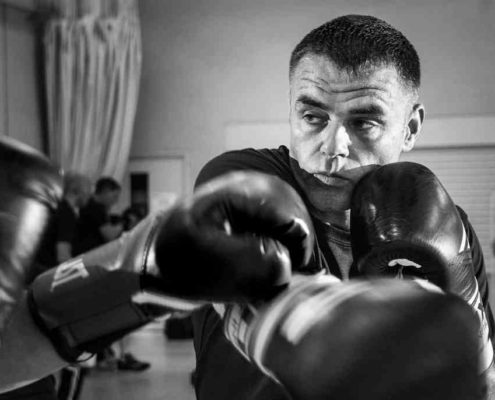What Is Krav Maga?
Krav Maga is a self-defense system developed in the mid-20th century with the aim of providing practical techniques for real-world situations. Originally created by Imi Lichtenfeld for the Israeli military, it draws on elements from boxing, wrestling, judo, Muay Thai, and Brazilian Jiu-Jitsu. The system emphasizes efficiency, simplicity, and adaptability under stress.
Unlike traditional martial arts, which often include structured forms, sport competitions, or philosophical components, Krav Maga is focused on neutralizing threats as quickly and directly as possible. Techniques are designed to be easy to learn, retain, and apply under pressure, making the system accessible to people with varying levels of physical ability and experience.
For a deeper look at its guiding principles, see our overview of Krav Maga principles.
Civilian and Professional Use
Although it began as a military system, Krav Maga has since been adapted for use by civilians, law enforcement, and security personnel worldwide. Civilian training generally includes responses to common threats such as unarmed assaults, multiple attackers, and armed confrontations. Law enforcement variations may include techniques for controlling individuals, disarming weapons, or responding in confined environments.
Across these contexts, Krav Maga maintains a focus on situational awareness, fast decision-making, and the use of natural, instinctive movements. The objective is not to engage in prolonged fights but to create an opportunity to escape or take control of a situation.
You can explore how this applies locally through our self-defence classes in Bristol.
Training Approach
A typical Krav Maga training session may cover striking, grappling, and defenses against grabs, chokes, or weapons. While techniques are drawn from multiple combat sports and martial arts, they are integrated with a focus on realism and practicality. Scenario-based drills are often used to simulate stressful or unpredictable conditions.
Groundwork is also part of the system, particularly when adapted from Brazilian Jiu-Jitsu and wrestling. You can learn more in our guide to combat grappling techniques for self-defense.
Krav Maga incorporates verbal de-escalation strategies and decision-making under pressure, particularly in programs tailored for non-military users. This practical, situational approach is what sets it apart from many traditional martial arts systems.
Evolution of the System
Krav Maga continues to evolve as new challenges and contexts arise. It is not tied to a specific set of forms or techniques, and instructors may adapt the material to reflect updated understandings of violence, security, and training methods. This flexibility has contributed to its adoption across different countries and sectors.
Training methods also benefit from advances in conditioning and sport science. For example, many programs now integrate strength and cardio components like kettlebell training, pad work, and interval conditioning.
Practicing Krav Maga in Bristol
At our club in Bristol, we approach Krav Maga as a practical system built on evidence, not tradition. We regularly incorporate real-world data to help shape how we train. For example, research suggests that around one in four violent incidents involve a weapon, and nearly half of all stranger assaults involve multiple attackers. These scenarios are rarely addressed in combat sports, which typically focus on one-on-one encounters under controlled conditions — so we include them proportionally, based on how often they actually occur.
We use MMA as the foundation for our striking and grappling. It’s proven, effective under pressure, and gives students a solid base in movement, striking, clinching, and defense. But we go further — we look at which techniques continue to work when things get chaotic or unpredictable, and we adapt them for real-world situations. That means training for things MMA doesn’t usually cover, like multiple attackers, weapon threats, and high-stress confrontations in less controlled environments.
Our team brings experience from Muay Thai, MMA, and front-line security work, so alongside self-defense, we also place a strong emphasis on learning how to fight — with sparring, timing, positioning, and pressure management built into the process.
A typical session may include:
-
Technique drills focused on striking, grappling, and situational responses
-
Padwork to develop power, targeting, and rhythm
-
Controlled sparring to apply skills against resistance
-
Grappling and clinch work for close-quarters control
-
Pressure testing to simulate stress, confusion, and unpredictability
A Note on Krav Maga Schools
Krav Maga is taught in many different ways, and not all clubs train the same way. Some avoid contact altogether — no sparring, no grappling, no resistance. Others may focus only on drills without any pressure testing.
It’s also worth noting that not every instructor has a verified or practical background, despite appearances. If you’re comparing clubs, it’s worth asking:
- Do students train against fully resistant opponents?
- Is contact sparring part of the curriculum?
- What experience does the instructor actually have — in combat sports, real-world settings, or both?
We keep our training transparent. Our team draws on real experience and keeps sessions grounded in what works under pressure.
Bristol Titans Krav Maga Classes in Bristol
We run structured classes for both adults and kids, with sessions tailored to experience level. If you’re curious about how it all works, our FAQ explains what to expect, and our reviews offer insight into how students experience our approach.

